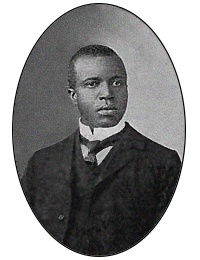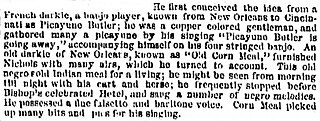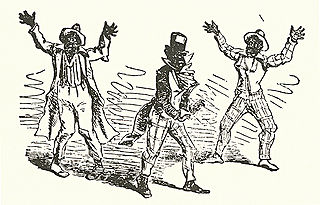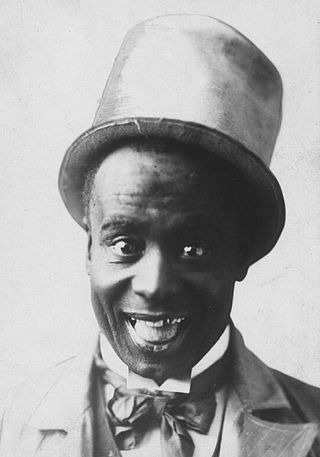Jazz is a music genre that originated in the African-American communities of New Orleans, Louisiana, in the late 19th and early 20th centuries, with its roots in blues and ragtime. Since the 1920s Jazz Age, it has been recognized as a major form of musical expression in traditional and popular music. Jazz is characterized by swing and blue notes, complex chords, call and response vocals, polyrhythms and improvisation. Jazz has roots in European harmony and African rhythmic rituals.
Ragtime, also spelled rag-time or rag time, is a musical style that had its peak from the 1890s to 1910s. Its cardinal trait is its syncopated, or "ragged" rhythm. Ragtime was popularized during the early 20th century by composers such as Scott Joplin, James Scott and Joseph Lamb. Ragtime pieces are typically composed for and performed on piano, though the genre has been adapted for a variety of instruments and styles.

Scott Joplin was an American composer and pianist. Dubbed the "King of Ragtime", he composed more than 40 ragtime pieces, one ragtime ballet, and two operas. One of his first and most popular pieces, the "Maple Leaf Rag", became the genre's first and most influential hit, later being recognized as the quintessential rag. Joplin considered ragtime to be a form of classical music meant to be played in concert halls and largely disdained the performance of ragtime as honky tonk music most common in saloons.

The United States' multi-ethnic population is reflected through a diverse array of styles of music. It is a mixture of music influenced by the music of Europe, Indigenous peoples, West Africa, Latin America, Middle East, North Africa, amongst many other places. The country's most internationally renowned genres are traditional pop, jazz, blues, country, bluegrass, rock, rock and roll, R&B, pop, hip-hop/rap, soul, funk, religious, disco, house, techno, ragtime, doo-wop, folk, americana, boogaloo, tejano, reggaeton, surf, and salsa, amongst many others. American music is heard around the world. Since the beginning of the 20th century, some forms of American popular music have gained a near global audience.

Benjamin Robertson Harney was an American songwriter, entertainer, and pioneer of ragtime music. His 1896 composition "You've Been a Good Old Wagon but You Done Broke Down" is the second ragtime composition to be published and the first ragtime hit to reach the mainstream. The first Ragtime composition published was La Pas Ma La written by Ernest Hogan in 1895. It has been disputed by many historians on whether or not, "You've Been a Good Old Wagon but You Done Broke Down" was released in late 1895 or early 1896. On the front cover of "You've Been a Good Old Wagon but You Done Broke Down", its listed as being copyrighted on 1895. However on the first page, its listed as being copyrighted in 1896. During the early years of Harney's career, he falsely promoted himself as being the inventor of ragtime and never acknowledged the genre's black origin. Many contemporary musicians criticized him for it. Although ragtime is now probably more associated with Scott Joplin, in 1924 The New York Times wrote that Ben Harney "Probably did more to popularize ragtime than any other person." Time magazine called him "Ragtime's Father" in 1938.

The cakewalk was a dance developed from the "prize walks" held in the mid-19th century, generally at get-togethers on Black slave plantations before and after emancipation in the Southern United States. Alternative names for the original form of the dance were "chalkline-walk", and the "walk-around". It was originally a processional partner dance performed with comical formality, and may have developed as a subtle mockery of the mannered dances of white slaveholders.
The music of Louisiana can be divided into three general regions: rural south Louisiana, home to Creole Zydeco and Old French, New Orleans, and north Louisiana. The region in and around Greater New Orleans has a unique musical heritage tied to Dixieland jazz, blues, and Afro-Caribbean rhythms. The music of the northern portion of the state starting at Baton Rouge and reaching Shreveport has similarities to that of the rest of the US South.
Discography is the study and cataloging of published sound recordings, often by specified artists or within identified music genres. The exact information included varies depending on the type and scope of the discography, but a discography entry for a specific recording will often list such details as the names of the artists involved, the time and place of the recording, the title of the piece performed, release dates, chart positions, and sales figures.

John "Picayune" Butler was a black French singer and banjo player who lived in New Orleans, Louisiana. He came to New Orleans from the French West Indies in the 1820s. One of his influences was Old Corn Meal, a street vendor who had gained fame as a singer and dancer at the St. Charles Theatre in 1837. By the 1820s, Butler had begun touring the Mississippi Valley performing music and clown acts. His fame grew so that by the 1850s he was known as far north as Cincinnati. In 1857, Butler participated in the first banjo tournament in the United States held at New York City's Chinese Hall, but due to inebriation, he only placed second.

A walkaround was a dance from the blackface minstrel shows of the 19th century. The walkaround began in the 1840s as a dance for one performer, but by the 1850s, many dancers or the entire troupe participated. The walkaround often served as the finale to the first half of the minstrel show, the opening semicircle. Minstrels also wrote songs called "walkarounds", which were specifically intended for this dance; "Dixie" is probably the most famous example.

Ernest Hogan was the first African-American entertainer to produce and star in a Broadway show, The Oyster Man in 1907, and helped to popularize the musical genre of ragtime.

Ian Timothy Whitcomb was an English entertainer, singer-songwriter, record producer, writer, broadcaster and actor. As part of the British Invasion, his hit song "You Turn Me On" reached number 8 on the Billboard Hot 100 chart in 1965.

An egg dance is a traditional Easter game in which eggs are laid on the ground or floor and the goal is to dance among them, damaging as few as possible. The egg was a symbol of the rebirth of the earth in Pagan celebrations of spring, and was adopted by early Christians as a symbol of the rebirth of man at Easter.
This is a timeline of music in the United States from 1880 to 1919.
Set de flo' was a type of dance competition held among African Americans during the 19th century.

Stick dance was a dance style that African–Americans developed on American plantations during the slavery era, where dancing was used to practice "military drills" among the slaves, where the stick used in the dance was in fact a disguised weapon.
Ulysses "Slow Kid" Thompson was a comedian, singer, tap and acrobatic dancer whose nickname was inspired by his ability to perform a comical, and incredibly slow, dance routine. His career included work in circus, medicine, minstrel, vaudeville, and Broadway.

Alice Matilda Lethbridge was an English music hall dancer and Gaiety Girl, best known for her "skirt dance" act.
The douga or the "dance of the vultures" is a ceremonial dance among the Mandinka people of West Africa.












